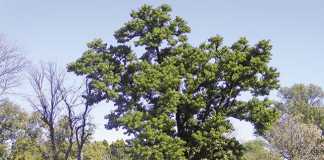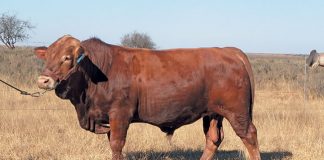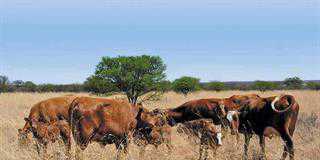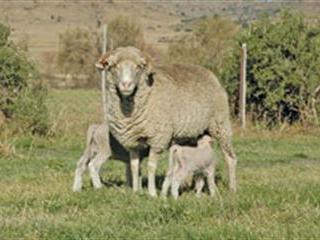
Despite being famed for its wool, the Merino suffers from a serious drawback: a markedly wrinkled skin on the breech. This tends to attract dirt and hence flystrike, which if left untreated, can be fatal. To obviate the problem, the practice of mulesing was developed: the pleats of skin are cut away in lambs. The method, though effective, is painful and is strongly opposed by animal rights groups, especially in Australia.
In the 1980s, Henri McNaughton of the farm Houdconstant in the Graaff-Reinet district realised that a far better solution would be to eliminate, as far as possible, the wrinkled skin on the breech. He crossed the traditional Merino with the Geelbek Merino strain, and after much experimenting, developed the Charmac Merino, which has fewer skin pleats and requires no mulesing.
Over the years, Henri, with his sons Adrian and Ronald, continued to breed the Charmac on the family’s 4 500ha farm, increasing flock size in number to about 800 stud and 1 500 commercial ewes.
Down under
In 2007, the breed caught the attention of wool growers in Australia. Because of a traditional emphasis on wool, the Australian Merino is more pleated than the modern SA Merino, which is bred for 35% wool and 65% meat production. More pleats mean that mulesing is essential, yet it is a practice condemned by the country’s powerful animals rights groups.
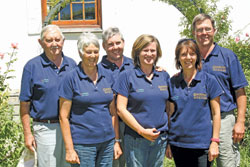
The McNaughton family are all involved in various aspects of the business. From left: Henri and Charné, Ronald and Sandra, and Elsanne and Adrian.
The McNaughtons formed a joint venture to export 200 Charmac embryos and develop the breed Down Under. “Our joint venture Australian partners, Leon and Sandra Martin, farm in the Albury district in New South Wales. They recognised the potential of an ethically produced, made-from-wool fabric in Australia, where there is pressure for ‘humanitarian husbandry,” Adrian explains.
Once they had established the Charmac flock, which is run on lucerne, grass and clover pasture on their 130ha farm, the Martins approached Albury-based wool industry consultant David Tester and Macquarie Textiles for assistance. Together, they developed a pure wool crépe weave similar to chiffon, using fine and medium micron wool from the Charmacs. The fabric, named Wool Charné in honour of Charné McNaughton, was launched in June this year and is currently being tested by top Australian fashion designers.
Leon Martin explains that they also chose Charmac because its wool is white and has elasticity, drape and softness. Moreover, it is lightweight, breathes well and has a luxury sheen. This means that a naturally white garment can be made without bleaching the wool, a process that damages the fibre and removes some of the sheen. Macquarie Textiles was happy to collaborate in developing Wool Charné because, like many textile fabric manufacturers, it faces fierce competition from China, which processes wool far more cheaply. To produce a high-end fabric is a possible lifeline for the company as the process requires specialist input.
Management back in SA
Henri, while officially retired to Sedgefield, is still actively involved in the Charmac stud. The day-to-day running of the farming enterprise, however, is now left to Adrian and Ronald. “We both live on the farm and operate in a partnership: we each have a section of the farm to look after with our own staff,” Adrian explains. He takes care of the Charmac stud and the farm’s 70ha of lucerne, which is irrigated with a Floppy Sprinkler and dragline system.
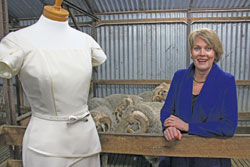
Sandra Martin with a Wool Charné couture dress made from Charmac wool. Sandra and her husband Leon farm in New South Wales and recognised the potential of an ethically produced wool fabric. Photo courtesy of Adrian McNaughton
The lucerne is cut, baled and fed to the ewes in the lambing camps in the veld. Ewes with twins are also run on the pastures.
Ronald looks after the veld management of the farm. The natural vegetation is a combination of suurpol or mountain wiregrass (Merxmuellera disticha), red grass (Themeda triandra) and Karoo bossieveld and this is used for grazing the family’s commercial Charmac sheep flock, Bovelder cattle and Boer goats. Ronald also takes care of predator control with his pack of hounds.
The partnership works well. “We are fortunate in that we enjoy different aspects of farming and give each another the space to develop our respective strengths,” says Adrian. “It also gives us peace of mind to know that someone trustworthy is on the farm when either of us is away. And it’s good to know we can phone our father when we need his advice, which is pretty often.”
In demand
The average price paid for their stud rams at the February sale this year was R10 000, with the highest priced ram selling for R33 000. The average price this year is R7 600. The McNaughtons also sell 300 to 400 pregnant flock ewes out of hand each year. To meet the demand of buyers with different preferences, Henri developed a polled line and a horned line in the Charmac stud.
“We still feel the horned rams are of a better quality because of a more established genetic base,” explains Adrian. “The polled Charmac gene pool has only really been developed since the nineties, so it’s behind in terms of the larger gene pool. But it’s catching up.” He admits, though, that polled sheep are easier to handle in the kraal, and polled rams do not fight as much as horned rams, resulting in less blowfly strike on the head.
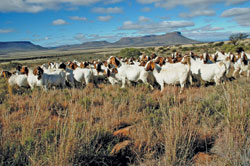
The family tried to run Angoras on Houdconstant but the area’s intense cold proved too much for the breed. Their 120-strong Boer goat flock has been considerably more successful .
Adrian is pleased with the Charmac’s general performance. “Out of the 40 Merino ram production sales in South Africa between January and March, 16 included Charmac genetics. Buyers either purchased Charmac stud rams, or semen via Ramsem,” he says. Semen from Alpha, one of the best rams the McNaughtons have ever bred, has been used throughout the country and all the top-priced rams at the family’s February sale were his sons.
“His body conformation, the yield and fineness of his wool, the fact that he is early maturing, which is popular these days, and his BLUP values are all favourable,” explains Adrian. At weaning and again at 12 months, the rams are assessed visually and all those below standard are slaughtered. The ewes are graded at 12 months and then performance-tested. The McNaughtons base their selection on wool quality and conformation.
Although they use BLUP and the Falkirk carcass-scanning tests as an aid, they believe their most important selection tools are their hands and eyes. “We feel and look at the wool as well as the animal’s conformation. We won’t use any sheep in our stud that doesn’t pass our hand and eye test, even if it has the best figures in the world,” insists Adrian. Traits for good conformation, he explains, include a square animal with depth and body length, and plenty of mutton in relation to bone.
In addition, the traits must be in balance. Quality wool includes soft handling and a bright sheen with a regular crimp and fluid yolk. Indeed, it was the quality of their Charmacs’ carcasses that landed the McNaughtons their Australian deal. Falkirk test developer New Zealander Ian Walsh was so impressed with how the carcasses scanned that he introduced them to Leon and Sandra Martin.
Australia – and the future
The Martins’ Charmac ewes are due to lamb this month and the first 30 rams are now available for sale. If the fabric takes off among Australia’s top fashion designers, the McNaughtons might find themselves exporting washed wool to Australia to supplement the Charmac flock there. “It’s still early days but it’s an exciting time for us, and this type of niche initiative is good news for all wool growers,” says Adrian. “We’re specifically going for a high-end, exclusive market and anticipate significant demand.”
Contact Adrian McNaughton on 049 845 0155 or 082 649 1553, email [email protected] or visit www.charmac.co.za. Guesthouse website: www.hgfarm.co.za











